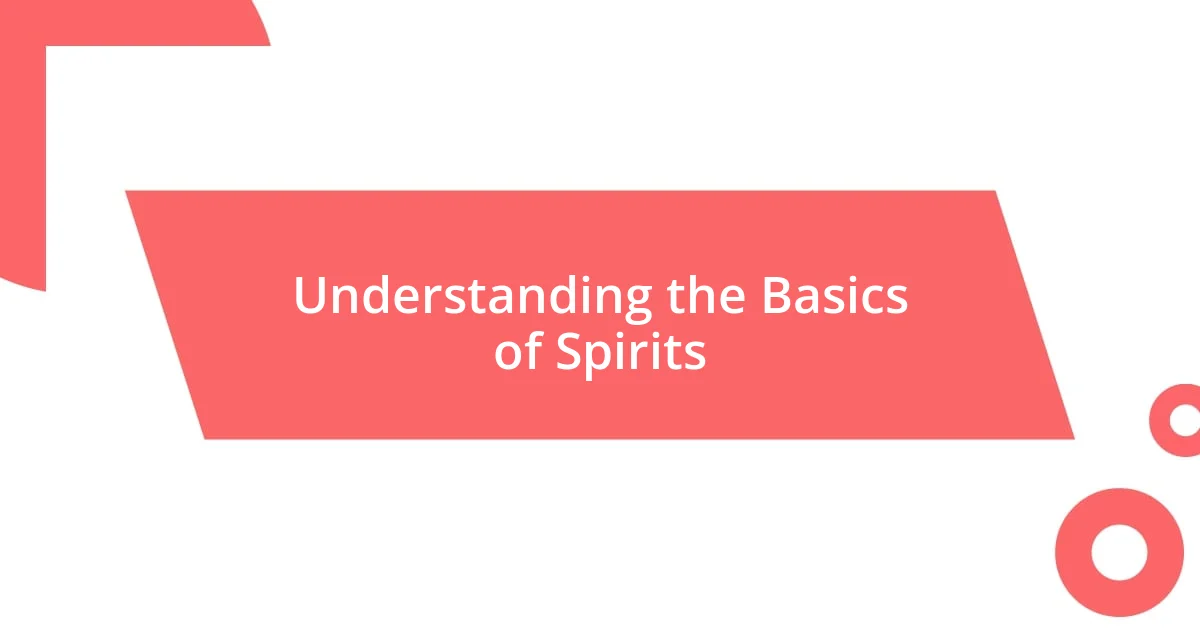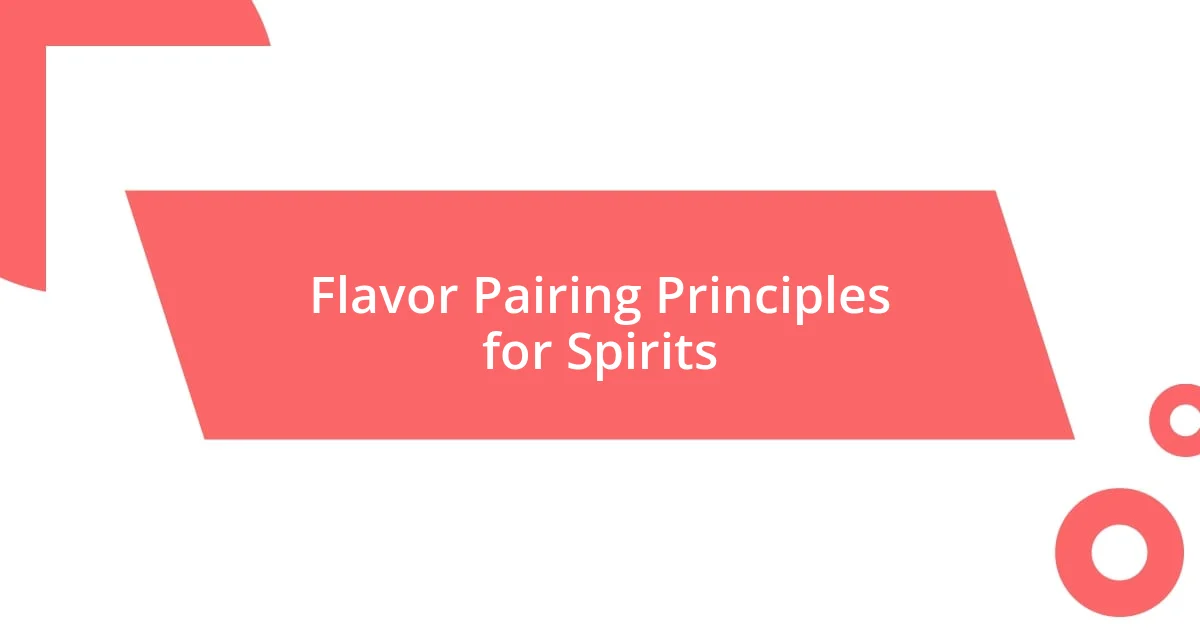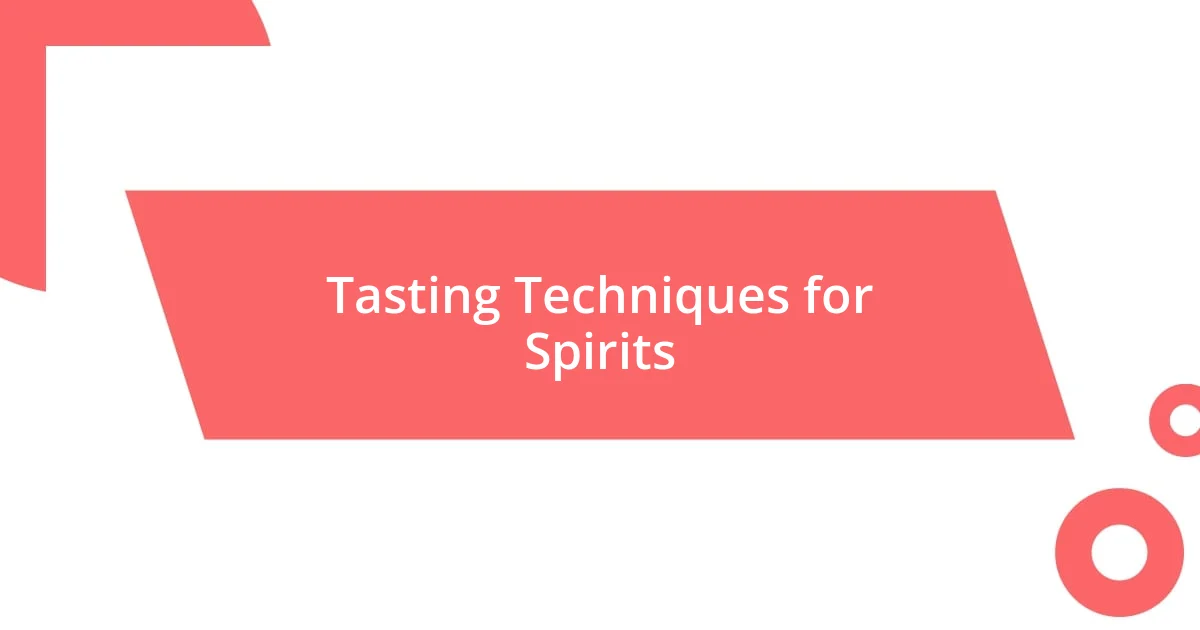Key takeaways:
- Spirits are distilled alcoholic beverages crafted through fermentation, with each type offering unique flavor profiles influenced by ingredients and geography.
- Successful flavor pairings rely on principles like balance, contrast, and seasonal ingredients, encouraging experimentation to enhance the drinking experience.
- Tasting techniques such as the “nose and sip” method and sharing experiences with friends can deepen appreciation and highlight subtle flavors in spirits.

Understanding the Basics of Spirits
Spirits are essentially distilled alcoholic beverages, crafted through a unique fermentation and distillation process. I still remember my first encounter with a small-batch gin; the fragrant botanicals danced on my palate and created an experience far more vibrant than any cocktail I had tried before. Isn’t it fascinating how each spirit tells its own story, shaped by geography, ingredients, and craftsmanship?
The production of spirits involves various raw materials, from grains in whiskey to sugarcane in rum. I’ve often found myself intrigued by the diverse flavor profiles that arise from such simple beginnings. Have you ever thought about how a mere grain can transform into something that warms the heart or ignites the party? This transformation is truly magical, highlighting the artistry behind spirit-making.
When we talk about spirits, we often refer to their categorization—think of whiskey, vodka, rum, and gin. Each category carries its own rules and flavor characteristics, which can sometimes feel overwhelming. However, I’ve learned that indulging in the tasting process helps to demystify these differences. Finding that perfect spirit for your palate can feel like discovering an old friend, one that you never knew existed but instantly connect with.

Flavor Pairing Principles for Spirits
When it comes to flavor pairing in spirits, I’ve discovered that balance is key. For instance, with gin—which usually boasts a mix of herbal and floral notes—I enjoy complementing it with citrus elements like lemon or grapefruit. It’s like a dance of flavors, where both the spirit and the mixer enhance each other without one overpowering the other.
Here are some essential flavor pairing principles to consider:
- Contrast: Bold flavors can elevate each other, like pairing a smoky mezcal with a sweet fruit juice.
- Matching Intensity: Pair lighter spirits, like vodka, with delicate mixers, while robust spirits, like aged rum, call for richer ingredients.
- Herbal and Spice Synergy: Incorporate herbs or spices that align with the spirit’s botanicals to create a harmonious experience, such as mint in mojitos.
- Sweetness vs. Bitterness: Balance sweet spirits with bitter elements to create a complex palate experience.
- Seasonal Ingredients: Think about the seasonality of flavors, adjusting pairings to reflect what’s fresh and vibrant during the time of year.
In my experience, I’ve often found that the best pairings come from experimentation. The first time I zipped fresh basil into a gin cocktail, the bright and savory burst was a revelation, turning a straightforward drink into a memorable moment. Trust me, discovering your favorite combinations is a delightful journey worth embarking on!

Complementary Ingredients for Pairing
I’ve come to appreciate how complementary ingredients can really elevate the experience of spirits. For instance, with an earthy tequila, adding a splash of green apple or cucumber not only balances the spirit’s boldness but also refreshes the palate. I remember one evening sipping on a tequila cocktail garnished with cucumber slices; it felt surprisingly revitalizing, almost like a spa day in a glass!
When experimenting with pairings, I often think about texture as well as flavor. Imagine the delightful contrast of creamy coconut with a sharp spiced rum. The creaminess rounds the drink, while the spice adds just enough kick to keep things interesting. It’s these nuanced combinations that bring a depth to the sipping experience, much like layering in a good piece of music.
The key to successful pairing, I believe, lies in listening to your own taste buds. If you’re enjoying a smooth bourbon, consider pairing it with some bittersweet chocolate. It’s an instant indulgence! I had a moment recently where I tried this pairing, and the rich harmony between the chocolate and bourbon told a story of comfort—a sweet escape after a long day. Engaging with flavors this way can transform your drinking experience into something truly memorable.
| Spirit | Complementary Ingredient |
|---|---|
| Tequila | Green Apple |
| Spiced Rum | Coconut |
| Bourbon | Bittersweet Chocolate |
| Gin | Citrus Fruits |
| Mezcal | Sweet Fruit Juice |

Tasting Techniques for Spirits
Tasting spirits is a sensory journey that I truly cherish. One technique I often use is the “nose and sip” method, where I take a moment to inhale the aromas before tasting. It’s incredible how much the bouquet can tell you about the spirit. I remember a time with a well-aged whiskey—a swirl in the glass released warm notes of caramel and oak, which set my expectations for the first sip. Has any spirit ever surprised you with its scent?
Another approach I like involves savoring small sips, allowing the spirit to linger on my palate. This technique helps me identify the layers of flavor that unfold over time. I vividly recall savoring a particularly complex rum, where each tiny taste revealed something new—first vanilla, then hints of spice, and finally dark chocolate. It made me wonder: how much do we often rush through our tasting experiences without discovering the full depth of flavor?
Finally, I often find that tasting with friends enhances the experience, as discussing what we each perceive can open up new perspectives. Sharing thoughts invites a communal appreciation of the spirit, turning a simple tasting into a spirited discussion. Just the other day, while sampling a rich, smoky mezcal, my friend pointed out a subtle herbal note that I had completely missed. Isn’t it fascinating how collaboration can transform our understanding and enjoyment of what we drink?

Creating Signature Spirit Pairings
Creating signature spirit pairings is like crafting a personal masterpiece. I still remember my first attempt at pairing a smooth gin with a splash of grapefruit juice. The result was an unexpected zesty explosion that transported me to a sun-soaked terrace. How often do we stumble upon these delightful surprises? There’s something magical about finding that perfect balance.
When I think about signature pairings, the story they tell is just as important as the flavors. Once, while enjoying a fine mezcal, I paired it with a slice of pineapple. The result was a harmonious blend that danced on my palate, creating a vivid memory of a relaxing beach getaway. Have you ever experienced a flavor combination that instantly transports you to another place? Those are the pairings that stay with you.
I also find it exciting to experiment with seasonal ingredients for pairing. One chilly winter evening, I combined a rich bourbon with spiced pear syrup. The warmth of the bourbon coupled with the sweetness of the pear felt like a snug blanket, wrapping me in comfort. Isn’t it intriguing how flavors can reflect our moods and the seasons? Signature pairings are not just about the taste; they’re about evoking emotions and creating lasting connections.















